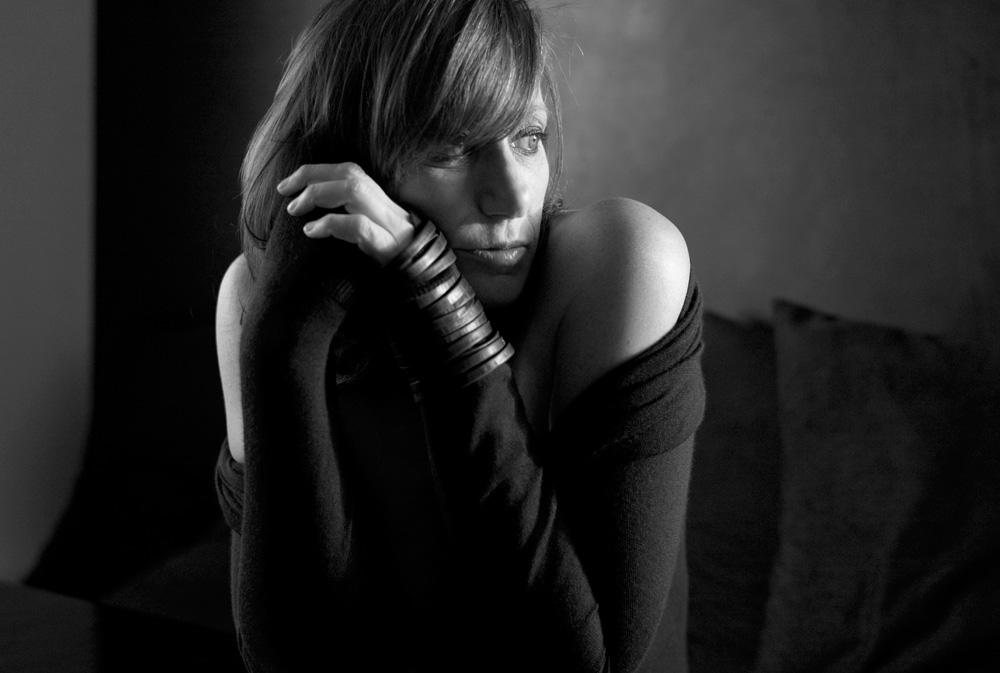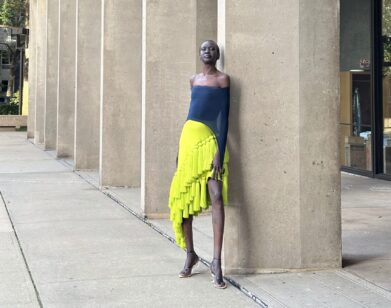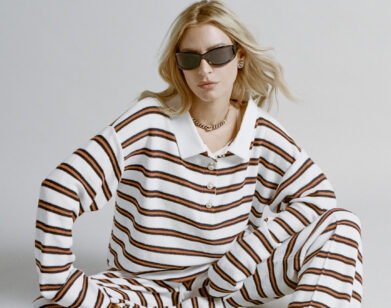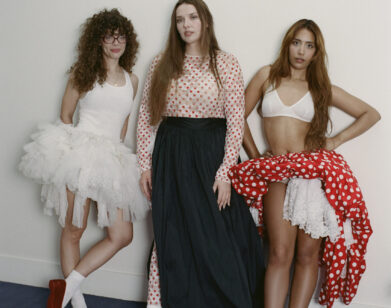Donna Karan
Donna Karan needs no introduction. And while we’re at it, neither does her best friend forever, Calvin Klein. Well, make thatBFF-L, for lately. These most iconic of NewYork’s designers have always had a lot in common, and, in recent years, they have become truly great pals and traveling companions. Donna is from Queens (Forest Hills), Calvin is from the Bronx (the Mosholu Parkway section), but today they belong to the globe, which they have been trotting together with increasing frequency. This year is the 20th anniversary of Donna Karan’s quintessential Gothamite brand, DKNY, and so on this occasion, who better to interview DK than CK?
CALVIN KLEIN: All right, let’s start at the beginning. I did my homework, dude. I remember seeing you in the elevator at 205 West 39th Street all the time, and then, suddenly, you were Anne Klein’s assistant. Then just as suddenly,Anne passed away, and the next thing I knew, you took over. Tell me what that felt like.
DONNA KARAN: It was not planned—at all. As a matter of fact, I was expecting a baby, who turned out to be Gabby. Anne goes into the hospital, I’m expecting a baby, and a collection is due, all on the same day. Thank god I was 10 days late! While Anne was in the hospital, I was going back and forth to Long Island like, “Holy shit.” It was a typical fashion-crisis moment, when everything is being created and born at exactly the same time. I go into labor, and Gunther Oppenheim, a partner at Anne Klein, calls me and says, “Where are you?” I say, “I’m in the hospital. I just had a baby. Would you like to know if I had a boy or a girl? By the way, I had a girl.” He says, “When are you coming back to work? The collection is due.” I said, “What do you mean, the collection is due?” I talked to the doctor and he said I had to wait a week. So Oppenheim says, “We’ll come to you.” They bring the entire collection to me with all of the people on the team. I’m looking at it, and it’s pre-Fall—which is one of the things I hate more than life itself, pre-Fall. That day, Anne died.
KLEIN: Did you think, Now I’m screwed?
KARAN: Was I scared? I was like, This is the most ridiculous thing I’ve ever heard of. I didn’t know what to do. I had just had a baby, so it was going to be about Gabby, not Anne Klein. [laughs] I was expecting to stay at home with my first baby, but that’s not the way the universe planned it. The universe really does . . . You don’t have that much choice in your life, which is one of the big lessons I’ve learned. I was going to be a designer whether I wanted to be a designer or not. So there I was.
KLEIN: So you just did it and you weren’t thinking, “Oh, my god, this is a huge business. Am I going into something that I’m prepared for?”
KARAN: There was a collection due, so, as a designer, I did it. I didn’t know what I couldn’t do, so I did my best. God bless my friend Kay Thompson. She pulled me through. She was the woman standing next to me holding my hand and making sure I wasn’t going to have a coronary. She pushed up her sleeves and got in there.
KLEIN: Does anything ever scare you?
KARAN: Everyday . . . Listen, right now I’m two weeks before a collection is due. I think this is probably one of the most challenging periods of our time. I’m scared today. As a designer, that’s the challenge that keeps me going. You know, What am I doing? It always feels like I’ve never done it before. But, at the same time, it’s been a lot of years. I mean, when we’re talking about Anne Klein—that was 1974.
KLEIN: You went from Anne Klein to Anne Klein II, and then at a certain point you started Donna Karan. I remember distinctly when that was—
KARAN: But do you remember what I said to you?
KLEIN: No, I don’t. You said many things to me all the time.
KARAN: When I met you in the elevator, I said, “Why don’t we join Anne Klein and Calvin Klein together and only have one Klein?”
KLEIN: Anne used to say that to me too, actually.
KARAN: We only needed one Klein out there. I said, “This is perfect. You do Spring. I do Fall. You do Fall. I do Spring.” It would’ve been such a perfect company. KLEIN: Forget Klein . . . [Karan laughs] When you started Donna Karan, did you have any idea what a global empire you were going to build?
KARAN: Not a clue. Because it was not my dream. It wasn’t my purpose. When I started Anne Klein II, we were really the first out there—
KLEIN: You were the first on a lot of things.
KARAN: But prior to that, at Anne Klein, the prices were $49.75. I’ll never forget that. That was the price of luxury sportswear at that point. Anne was a licensing person. She had the concept of licensing and the young designer working together . . . Anyway, after I started Anne Klein II, I had this brilliant idea: I wanted to design a collection that was not commercial. It was for me and my friends. I went to the owners of Anne Klein and said, “Listen, I want to start this little itty-bitty company. I can still do Anne Klein and Anne Klein II, but this little company is for my friends, a woman-to-woman kind of thing. They said, “Donna, you can’t do anything small. You wouldn’t know how to if you tried.” I said, “No, no. I really want to do just seven easy pieces. The concept is so simple. It’s the way that I dress. I like simplified stuff, and I think there’s a different customer for that.” And guess what they said? “Well, you know what? Basically, you’re fired.” [laughs] You have to understand that [designer] Louis Dell’Olio and I were partners at Anne Klein at that point. I always need a support team, even at Donna Karan. I like collaborating. There is something in collaboration that is wonderful.
KLEIN: I always think of your collaborations with Robert Lee Morris [jewelry designer, who first worked with Donna Karan in 1994]. They made such a strong statement. You did a lot for Robert and his jewelry, and what he was doing with you for your clothes said so much.
KARAN: It was just more fun that way. I don’t ever want it to be only about me.
KLEIN: So what makes you happy?
KARAN: Going to Africa with you. [laughs]
KLEIN: I was going to get to that later!
KARAN: Traveling. I’m a nature bug. You know I love nature. I love skiing, I love the sun, I love my children, I love my grandchildren, I love my family and friends . . . and whatever I haven’t done. Right now I’m on a mission. I have missions. I always see a void, a problem, and I’m there to fix a problem. So DKNY was a problem. There was a void in the market, so there it was—my daughter and her friends wearing all of my clothes. I couldn’t stand the fact that anybody else was dressing like me. It was supposed to be for me and my friends, not my daughter and her friends!
KLEIN: Wait. If you’re going to get into DKNY, I have to say that when you launched DKNY, I thought it was the most brilliant launch of any business on Seventh Avenue. It was so cohesive and courageous. You were a major designer, a name people knew around the world. And suddenly you were going into price points that designers didn’t do, and you did it with a vision. The name, the whole thing—it’s genius.
KARAN: I’ll explain the whole thing, because it’s really very simple. I had been displaced from Anne Klein. I had to go back to grassroots when I started Donna Karan. I found this little showroom with a kitchen, and that’s where I started it. Patti [Cohen, public relations director] came with me because she was at Anne Klein. She said, “You can’t do all of this by yourself. You’re going to need someone—to do tags, labels, all of those things.” I had forgotten about that stuff. When you’re used to having your own posse in a huge organization, to start something from scratch is a challenge. You know this more than anybody. When Donna Karan started, I didn’t like the name Donna Karan. [laughs] I had a real problem with it. I was so used to designing under somebody else’s name that I didn’t want to go out there with my own. I’m sitting in the kitchen, and I see the name “Maud Frizon/Paris, London” on a shoebox. I’m thinking, “That’s cool. What about Donna Karan New York?” Because it won’t be about me. It will be about New York City. Why New York City? Because New York City says the world. I wanted an international brand. Donna Karan’s just another boring name. So I called up [marketing executive] Peter Arnell and said, “How about Donna Karan New York?” He says, “What are the people in Los Angeles going to say?” [laughs] I’ll never forget that.
KLEIN: That’s so great.
KARAN: He says, “You’re crazy. You can’t call it Donna Karan New York.” I go, “Why? I want everything to be about New York.” He says, “How are people living in the rest of the country gonna look at it?” I said, “Well, everybody lives in New York. I mean, everybody relates to New York as a bridge to the world.” So that’s how New York came in. Then things started to get juicy. I wanted to play myself down and play up New York, because I figured Ralph Lauren owns America, you own sex, what was I going to own? [laughs] I was frustrated. But DKNY came out of the inspiration I got from your jean business. Jeans are jeans—they are the core essence of American fashion, in my opinion.
KLEIN: I remember that the launch of DKNY was pretty amazing.
KARAN: When DKNY launched, I didn’t tell my partners about it at the time. They had no idea. I said, “I want to do a collection that is androgynous, that is not about women, not about men, not about children. It could be about dogs, about anything that our family communicates with—what are the pieces that are universal? She was his, he was hers . . . We both wear a blazer, and we both wear a T-shirt.” So it’s based on a man’s approach, and I wanted to start with menswear—men’s and womenswear. And Stephan [Weiss, Karan’s late husband] at that point said to me, “Donna, you can’t start with men’s, unless you do luxury men’s. If you start men’s at a less expensive rate, you’ll never be able to do luxury men’s.” I said, “Listen, this is my vision. I see it as the seven-easy-pieces collection.” It was the men’s blazer, a pair of jeans, a navy-blue blazer, a utility jumpsuit, an anorak, an oversized sweater, and a pair of Keds sneakers. All I wanted was to have these pieces in Times Square to show that this is New York and the streets of New York. People always asked me, “How does Donna Karan see New York?” I’d say, “In a car.” Then they’d ask, “How about DKNY?” And I’d say, “In a subway or a bus.” That was the difference.
KLEIN: If you were Donna Karan, was Gabby DKNY?
KARAN: I see DKNY as my other life. It was the embraceable life. It was when I’m not working. I saw it as my sport life, my Hamptons life, my casual life.
KLEIN: How did you end up dividing your time? You must have been doing Donna Karan day and night, 24/7, to begin with. How did you make that transition?
KARAN: It was very simple. I have a designer who was with me at Anne Klein who came with me to Donna Karan. Her name is Jane Chung. I taught her at Parsons School of Design, and she said to me, “I wanna give DKNY a shot.” And she has been there from the very, very beginning. She truly is the launch of DKNY. As I said, collaboration is really key for me. KLEIN: I remember having a discussion with Karl Lagerfeld once about being involved with different collections and design studios and designers. Neither of us thought it was very easy. It’s so much work. No matter how many people you have helping, there’s still just one Donna Karan. But you seem to have the approach that working with different people is more of a pleasure than a headache.
KARAN: The inspiration goes both ways. The magic happens in the creative studios. But sometimes you’re inspired when you’re removed from it a little bit. That’s when the juice starts to percolate.
KLEIN: The fact is, you could talk about collaboration from now until next Christmas, but you’re the inspiration. You’re the woman who has built this global empire. Don’t you ever think about that?
KARAN: No. It’s a bit like passing the baton. When you grow a business, it belongs to a lot of other people besides you. As much as you want to control it, the minute you go public, it becomes a business . . . But obviously DKNY meant a lot to me in terms of vision. I wanted it not to be about fashion. I wanted it to be about the food you eat, the objects of desire. I wanted it to be about flea-marketing. I wanted it to have an energy that was beyond just the ready-to-wear component.
KLEIN: Can you believe that was 20 years ago?
KARAN: You’re double my age! Calvin Klein’s celebrating 40, darling . . . [laughs] This has to be a reverse conversation. I feel like your child.
KLEIN: I feel like that sometimes, too. In Africa . . . Do you ever get bored?
KARAN: Completely. That’s why The Urban Zen Foundation [a nonprofit Karan co-founded in 2006] was started. I saw the next dimension. I couldn’t help but see . . .
KLEIN: So that means you needed a new challenge?
KARAN: Constantly. I think it is a challenging period of time, which is more stimulating than I would say most times are. It’s not business as usual. It’s scary, but right now we’re looking at a time when we have to protect this industry. There was a time when it was just rhythmic. I think now we’re being called into action. It’s the sewers, the fabric people, the manufacturing—people’s lives are at stake. If I look at fashion from that point of view, I feel socially responsible.
KLEIN: I’ve known you for so long, but I don’t know how the spiritual side enters your work.
KARAN: [laughs] You should’ve come to some of my shows when the didgeridoos were walking down the runway . . . It’s very simple. My bodysuit is how I start everyday. I wear a bodysuit everyday of my life. It’s how I start my yoga practice. It’s underneath it all. For me, what goes under the clothes is as important as what goes on top of the clothes. It’s a layering aspect, so it’s inside. We could dress ourselves till we’re deaf, dumb, and blue in the face. I was extremely blessed and successful at a very, very young age, but I had to start asking questions. What did this all mean? It didn’t make sense to me, so I started searching. I’ve been doing yoga since I was 18 years old. That took me on a journey, and once you start, you never stop.
KLEIN: I always thought Stephan had a lot to do with your success. He showed incredible support and love for you.
KARAN: I would not be here today if it weren’t for my husband. Stephan was my protector, my support. Stephan took care of all the “stuff” and allowed me to create. Stephan humbly stepped back as a person who would be out there in the art world . . . To be able to say, two of us out there is too much—let’s let you be the face. You know, even though he’d be in his studio doing his artwork, which he loved, it was never his ego involved in letting him show his artwork. So Stephan had the intelligence, the vision, and everybody said “my pony-tailed husband,” because I had a creative husband who also had a brain.
KLEIN: He also pulled off one of the most brilliant sales of a company [Donna KARAN International to lvmh in 2001]. It was his way of seeing that you were protected if he wasn’t able to do that himself.
KARAN: It was his legacy. He had lung cancer and he wanted to protect me. Every day I celebrate my husband and the studio. That’s why Urban Zen is at the studio.KLEIN: In what sense was going through his illness an inspiration for you to start doing philanthropic work? Did you create Urban Zen to heal?
KARAN: I had always been involved in healing. As my husband would say, it was part of my “whoo-whoo trip,” and, unfortunately, it is a phrase that I think is used too lightly. But bringing Eastern and Western medicine together is of utmost importance and touches every single one of our lives. The creativity that happens in that studio is mind-blowing to me. And the humbleness . . . I realized very quickly what was missing in the medical system, because he needed all of those tools to get through his eight years of dealing with cancer. He needed yoga principles to help him breathe. He needed the acupuncture. He needed the Chinese herbs. He needed all the therapies. And he needed somebody to help him along the path. On a philanthropic level, I was always dealing with disease. I was dealing with the AIDS epidemic. But then what had happened—when Stephan got cancer and Liz Tilberis [former Harper’s Bazaar editor in chief] got ovarian cancer—it became more a matter of how to bring a community together that wants to make a difference in this world, on a medical level. And then I saw the void. Another void. This void was about patient care and advocacy. Who is caring for patients? We are all gonna be patients. How do you go through it? So we created the Urban Zen Integrative Yoga Therapist Program.
KLEIN: How does spirituality come into all this?
KARAN: It’s all part of it.
KLEIN: What does spirituality mean to you?
KARAN: For me, the soul is connected to a higher being. It’s not about religion; it’s about connecting to your true self—your truth, the truth inside of you, the one you were born with. I’ve had to make corrections in my life . . . [laughs] And I’m here to correct them. So my spiritual connection is about embracing everything around me. You know, we’re all the same. There are no boundaries . . . This might be too heavy for a lot of people. [laughs]
KLEIN: I want to ask you a series of questions, and you tell me the first thing that comes to your mind . . .
KARAN: Africa!
KLEIN: Okay, now I’m starting. What is your biggest faux pas?
KARAN: Oh, god, this is hard . . . My biggest faux pas is not giving time for myself.
KLEIN: Who is your style icon?
KARAN: [pauses] I don’t have one.
KLEIN: What’s your favorite guilty pleasure?
KARAN: Travel, getting outta here, leaving my responsibilities, escaping . . .
KLEIN: I always thought of you as an adventurer, and I was finally convinced when we went to Africa together. Do you see yourself that way?
KARAN: Absolutely. Ask me, if I had one dream right now, what would that dream be?
KLEIN: What would that dream be, if you had one dream?
KARAN: For you and I to get on a boat and travel the world. We’d start in the East. I am dying to go to Papua New Guinea and really discover the East. There’s so much that I haven’t seen yet. I haven’t seen China.
KLEIN: I haven’t seen China either.
KARAN: I’ve never been to Russia! I really want to go—desperately. I know you’ve been to India, but I really want to get into the core of it.
KLEIN: We have to finish Africa.
KARAN: There are so many places I haven’t gone. I haven’t done the Nile yet. The clock is ticking . . .
KLEIN: I went to your surprise birthday party. It was fabulous. The best part was seeing the surprise on your face.
KARAN: It was shock!
KLEIN: And how much you enjoyed it. That was your 60th birthday party.
KARAN: You have to print that? I’m 60 going on 30! I haven’t grown up yet! It is a shock to my physical system because I don’t feel it. I think it’s just a number. I love to play, I love to dance, I love to party . . . I’m a liver. I think what I need to learn is how to find the calmness, the centeredness.
KLEIN: You mean, balance?
KARAN: How to find that simplicity. That adventurer in me is always seeking the unknown. And, when you see the clock ticking . . . You know, I don’t want to regret. But I don’t regret my work—I love the body, I love draping, I love the spontaneity of something coming from nothing. You and I both design houses and furniture like we’re doing a dress—we have fittings. We build life-size models as if they were muslin. We’re visual, tactile people. It’s an obsession . . . Ha! Good name for a fragrance. KLEIN: We both are grandparents. Tell me how it feels for you, having grandkids.
KARAN: I have seven of them. And there’s something about the things I wasn’t able to do with my own daughter that I’m able to relive with my grandchildren. Do you know what I mean?
KLEIN: Yes, that’s brilliant. Why are we such good traveling companions?
KARAN: We both love the visual. We both exist on the same sort of principles. You’re naughty, like I am, and adventurous and simple, like I am. I’m an earthy girl—earth mama. But I didn’t realize what an earth mama you were.
KLEIN: As soon as we landed in Ethiopia, you had 40 children around you, and I was thrilled because all I wanted to do was find the best-looking guy or girl, take them aside, and photograph them!
KARAN: I was so jealous! All I wanted to do was take their Polaroids and give them to them. That was my whole MO. Then I come home, and I don’t have any pictures, and you have a lot of them. I’m standing there going, “Look how Calvin sees this!” Your eye is so f-ing sharp. This is where we show our differences. You are more minimal and more of a purist, which I appreciate and am humbled by. And I’m more of an eclectic mess.
KLEIN: It’s the human thing. You often have a lot of people around you—you love people, and they sense it. They were running to you; they weren’t running to me. I came to Africa to do what I wanted to do, and you were saving every tribe.
KARAN: The funny part was how we didn’t want to go home. We were just like, “Okay, where should we go next? We need a next place!” If I could say what my dream would be, it would be to just keep going and not have to go home . . . We could just be able to truly experience. When else are you ever going to get to do it? We ain’t getting any younger . . .
KLEIN: I’m just waiting for you. I mean it. I’m ready.
For more on DKNY and Donna Karan, check out the Web site for DKNY.







